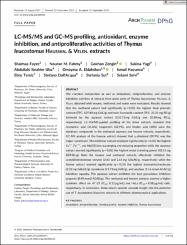LC-MS/MS and GC-MS profiling, antioxidant, enzyme inhibition, and antiproliferative activities of Thymus leucostomus HAUSSKN. & VELEN. extracts

Göster/
Erişim
info:eu-repo/semantics/openAccessTarih
2023Yazar
Fayez, ShaimaaFahmy, Nouran M.
Zengin, Gökhan
Yagi, Sakina
Uba, Abdullahi Ibrahim
Eldahshan, Omayma A.
Koyuncu, İsmail
Temiz, Ebru
Dall'Acqua, Stefano
Sut, Stefania
Selvi, Selami
Üst veri
Tüm öğe kaydını gösterÖzet
The chemical composition as well as antioxidant, antiproliferative, and enzyme inhibition activities of extracts from aerial parts of Thymus leucostomus H ausskn. & V elen. obtained with hexane, methanol, and water were evaluated. Results showed that the methanol extract had significantly (p < 0.05) the highest total phenolic content (TPC; 107.80 mg GAE/g) and total flavonoids content (TFC; 25.21 mg RE/g) followed by the aqueous extract (102.72 mg GAE/g and 20.88 mg RE/g, respectively). LC-MS/MS-guided profiling of the three extracts revealed that rosmarinic acid (34.8%), hesperetin (42.9%), and linoleic acid (18%) were the dominant compounds in the methanol, aqueous and hexane extracts, respectively. GC-MS analysis of the hexane extract showed that gamma-sitosterol (29.9%) was the major constituent. The methanol extract displayed significantly (p < 0.05) the highest Cu++, Fe+++, and Mo(VI) ions scavenging and reducing properties while the aqueous extract exerted significantly (p < 0.05) the highest metal chelating power (42.51 mg EDTAE/g). Both the hexane and methanol extracts effectively inhibited the acetylcholinesterase enzyme (2.63 and 2.65 mg GALAE/g, respectively) while the former extract exerted significantly (p < 0.05) the highest butyrylcholinesterase (2.32 mg GALAE/g), tyrosinase (19.73 mg KAE/g), and amylase (1.16 mmol ACAE/g) inhibition capacity. The aqueous extract exhibited the best glucosidase inhibition property (0.49 mmol ACAE/g). The methanol and hexane extracts exerted a higher cytotoxic effect on HT-29 (IC50: 8.12 mu g/mL) and HeLa (IC50 = 8.08 mu g/mL) cells, respectively. In conclusion, these results provide valuable insight into the potential use of T. leucostomus bioactive extracts in different pharmaceutical applications.

















